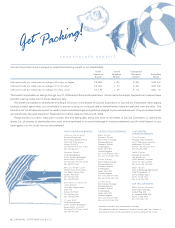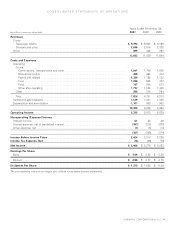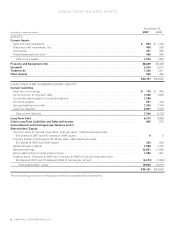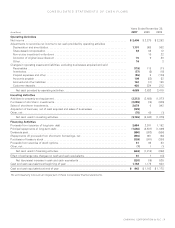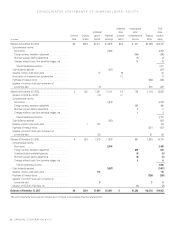Carnival Cruises 2007 Annual Report Download - page 16
Download and view the complete annual report
Please find page 16 of the 2007 Carnival Cruises annual report below. You can navigate through the pages in the report by either clicking on the pages listed below, or by using the keyword search tool below to find specific information within the annual report.CARNIVAL CORPORATION & PLC | 13
Compensation cost under SFAS No. 123(R) is recognized
ratably using the straight-line attribution method over the
expected vesting period or to the retirement eligibility date, if
less than the vesting period, when vesting is not contingent
upon any future performance. In addition, pursuant to SFAS
No. 123(R) we are required to estimate the amount of expected
forfeitures, which we estimate based on historical forfeiture
experience, when calculating compensation cost. If the actual
forfeitures that occur are different from the estimate, then we
revise our estimates. The effect of adopting SFAS No. 123(R)
in 2006 was to reduce our net income by $57 million and our
basic and diluted earnings per share by $0.07. Fiscal 2005
was not restated under this transition method.
Concentrations of Credit Risk
As part of our ongoing control procedures, we monitor con-
centrations of credit risk associated with financial and other
institutions with which we conduct significant business. Credit
risk, including counterparty nonperformance under derivative
instruments, contingent obligations and new ship progress
payment guarantees, is considered minimal, as we primarily
conduct business with large, well-established financial institu-
tions who have long-term credit ratings of A or above, and
we seek to diversify our counterparties. In addition, we have
established guidelines regarding credit ratings and investment
maturities that we follow to maintain safety and liquidity. We
do not anticipate nonperformance by any of our significant
counterparties.
We also monitor the creditworthiness of foreign travel
agencies and tour operators to which we grant credit terms
in the normal course of our business. Concentrations of credit
risk associated with these receivables are considered minimal
primarily due to their short maturities and the large number
of accounts within our customer base. We have experienced
only minimal credit losses on our trade receivables. We do not
normally require collateral or other security to support normal
credit sales. However, we do normally require collateral and/or
guarantees to support notes receivable on significant asset
sales and new ship progress payments to shipyards.
NOTE 3—DLC STRUCTURE
In 2003, Carnival Corporation and Carnival plc (formerly
known as P&O Princess) completed a DLC transaction, which
implemented Carnival Corporation & plc’s DLC structure. The
contracts governing the DLC structure provide that Carnival
Corporation and Carnival plc each continue to have separate
boards of directors, but the boards and senior executive man-
agement of both companies are identical. The amendments
to the constituent documents of each of the companies also
provide that, on most matters, the holders of the common
equity of both companies effectively vote as a single body. On
specified matters where the interests of Carnival Corporation’s
shareholders may differ from the interests of Carnival plc’s
shareholders (a “class rights action”), each shareholder body
will vote separately as a class, such as transactions primarily
designed to amend or unwind the DLC structure. Generally,
no class rights action will be implemented unless approved by
both shareholder bodies.
Upon the closing of the DLC transaction, Carnival Corporation
and Carnival plc also executed the Equalization and Governance
Agreement, which provides for the equalization of dividends
and liquidation distributions based on an equalization ratio and
contains provisions relating to the governance of the DLC
structure. Because the current equalization ratio is 1 to 1, one
Carnival plc ordinary share is entitled to the same distribu-
tions, subject to the terms of the Equalization and Governance
Agreement, as one share of Carnival Corporation common
stock. In a liquidation of either company or both companies,
if the hypothetical potential per share liquidation distributions
to each company’s shareholders are not equivalent, taking into
account the relative value of the two companies’ assets and
the indebtedness of each company, to the extent that one
company has greater net assets so that any liquidation distri-
bution to its shareholders would not be equivalent on a per
share basis, the company with the ability to make a higher net
distribution is required to make a payment to the other com-
pany to equalize the possible net distribution to shareholders,
subject to certain exceptions.
At the closing of the DLC transaction, Carnival Corporation
and Carnival plc also executed deeds of guarantee. Under the
terms of Carnival Corporation’s deed of guarantee, Carnival
Corporation has agreed to guarantee all indebtedness and
certain other monetary obligations of Carnival plc that are
incurred under agreements entered into on or after the closing
date of the DLC transaction. The terms of Carnival plc’s deed
of guarantee are identical to those of Carnival Corporation’s.
In addition, Carnival Corporation and Carnival plc have each
extended their respective deeds of guarantee to the other’s
pre-DLC indebtedness and certain other monetary obligations,
or alternatively have provided standalone guarantees in lieu of
utilization of these deeds of guarantee, thus effectively cross
guaranteeing all Carnival Corporation and Carnival plc indebt-
edness and certain other monetary obligations. Each deed of
guarantee provides that the creditors to whom the obligations
are owed are intended third party beneficiaries of such deed
of guarantee.



